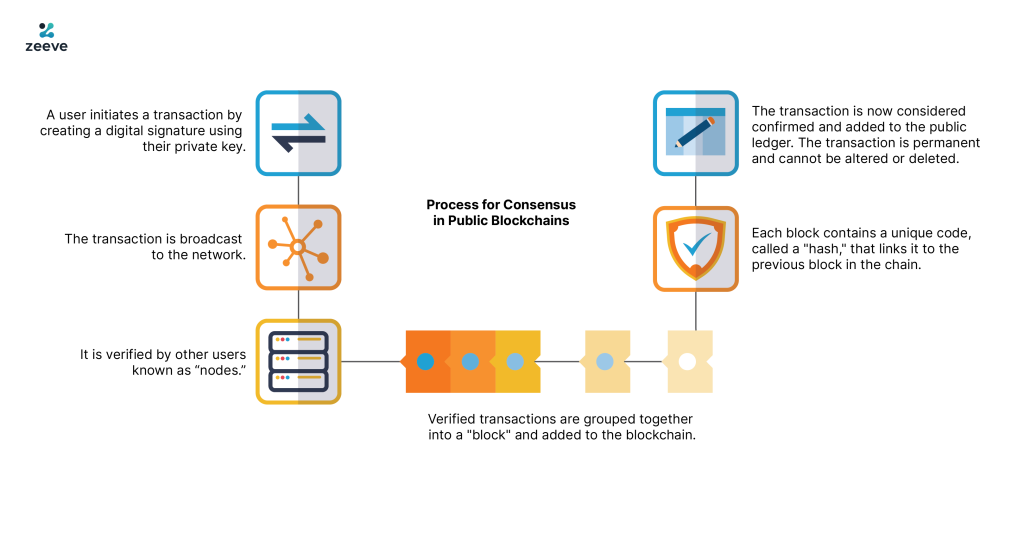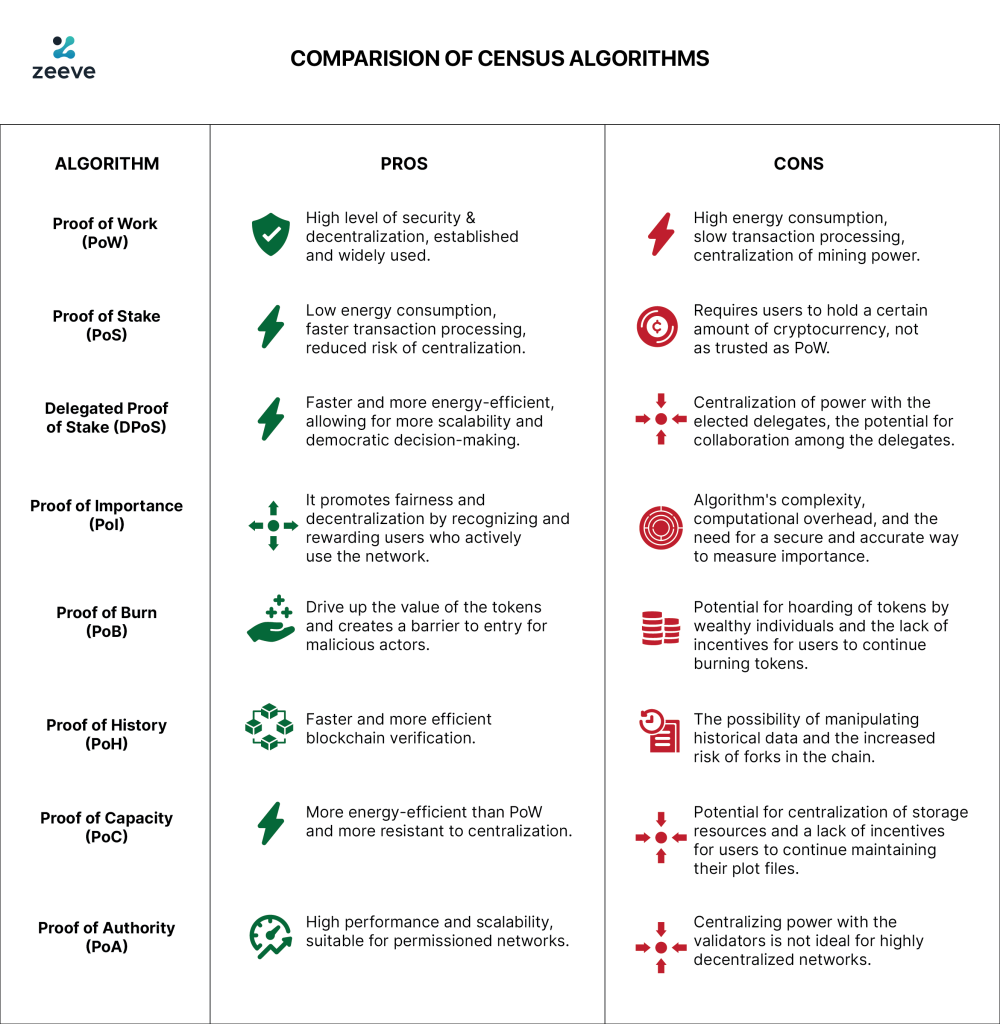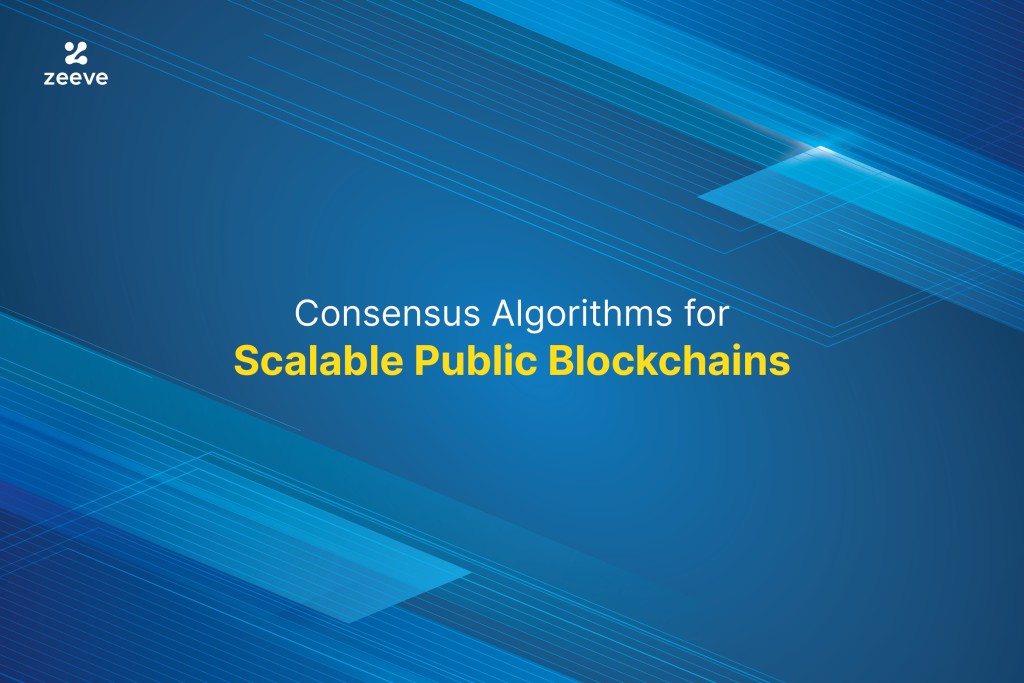In the ever-developing arena of public blockchains, consensus mechanisms serve as the linchpin for the authentication and inclusion of transactions into the ledger. To keep pace with the continuously burgeoning demands for expeditious and secure transactions, it is imperative that these mechanisms are engineered with scalability in mind.
From Proof of Work (PoW) and Proof of Stake (PoS), to Delegated Proof of Stake (DPoS) and Practical Byzantine Fault Tolerance (PBFT), the panoply of consensus mechanisms employed in large-scale public blockchains each boast their own idiosyncratic advantages and disadvantages. Ultimately, the choice of mechanism will hinge on the intricacies and specific requirements of the blockchain it is serving.
What constitutes Consensus in Public Blockchains and its Functionality?
Consensus refers to the modus operandi employed by multiple participants to reach a concurrence in a decentralized system, such as a blockchain network. The consensus mechanism is responsible for certifying transactions and generating new blocks in the blockchain.
The consensus procedure in a public blockchain is pivotal for preserving the security, stability, and veracity of the network by necessitating all users to concur on the state of the network without resorting to a central authority. The consensus mechanism ensures the network’s fortification against attacks such as double spending and resolves any possible conflicts.”

Procedures for Attaining Accord in Open-Source Blockchain Networks
Proof-of-Work (PoW)
PoW is a pervasive consensus strategy in public blockchains. It arose as the consensus mechanism for Bitcoin and has since been embraced by numerous other digital currencies. The approach encompasses validators, also referred to as miners, who engage in a competition to decipher a convoluted mathematical conundrum in order to validate transactions and incorporate them into the blockchain. The miner who successfully resolves the puzzle is remunerated with tokens, and the blockchain is augmented with the certified transactions. This sequence is denoted as “mining.”
PoW confers robust security as interfering with the blockchain is computationally challenging, rendering it onerous for malicious actors to launch attacks or exert control over the network.
However, PoW also exhibits some drawbacks, such as exorbitant energy consumption and concentration of mining operations. As the difficulty of mining escalates, more energy is required, and a smaller cohort of powerful mining pools will exert greater influence over the mining process.”
Proof of Stake (PoS)
Proof-of-Stake (PoS) is utilized by multiple cryptocurrencies, including Bitcoin, as a substitute for Proof-of-Work (PoW) as the consensus methodology. Open-source blockchain technologies adopt PoS as a means of resolving some of the problems intrinsic to PoW, such as its lack of efficiency and the concentration of mining capability.
In PoS, validators are selected based on the quantity of tokens they hold and are eager to pledge as collateral for authenticating and incorporating transactions into the blockchain. The probability of being selected to validate transactions increases in proportion to the number of tokens held by the validator, a process referred to as “staking.”
The act of pledging tokens encourages validators to act in a conscientious manner and preserve the security of the network. If a validator engages in malicious behavior, they can be expelled from the network and have their pledged tokens confiscated.
PoS requires fewer energy resources compared to PoW to validate transactions as it does not depend on computational power. This renders PoS a more sustainable and efficient alternative for blockchain protocols that necessitate elevated levels of security and efficiency.
Delegated Proof of Stake (DPoS)
DPoS is a widely adopted consensus mechanism within the domain of open-source blockchain protocols that harmonize Proof-of-Stake (PoS) and democratic governance. With the implementation of DPoS, token holders can bestow their responsibilities of transaction validation and record keeping to delegate entities. This, however, incurs a level of risk to the trustworthiness of both delegates and the network as a whole, thereby requiring delegates to operate with a heightened degree of accountability.
DPoS presents a more efficacious scaling solution in comparison to other consensus mechanisms, such as Proof-of-Work, due to its lower necessity for delegate validators, thereby enhancing transaction processing velocities and augmenting network throughput.
Token holders are empowered to exercise their franchise by voting for delegates they perceive to act in the most beneficial manner for the network, conferring a democratic element to DPoS. This democratic procedure results in a more decentralized and representative decision-making process, in contrast to the concentration of power in a handful of major mining pools that is characteristic of consensus systems like Proof-of-Work.
Practical Byzantine Fault Tolerance (PBFT)
An inconspicuous yet profound transformation is transpiring within the domain of open-source blockchain technology, with the potential to fundamentally alter the landscape of digital transactions. This transformation is epitomized by the advent of Practical Byzantine Fault Tolerance (PBFT), a consensus mechanism that has been instrumental in unlocking the full potential of blockchain systems.
PBFT is a mechanism that grapples with the intricate problem of Byzantine faults, wherein network nodes engage in intentional violations of the protocol or act with malicious intent. This solution has acquired a reputation for providing dependable security in decentralized environments, as evidenced by its widespread utilization among blockchain systems.
The modus operandi of PBFT is founded upon collaboration and consensus among network nodes, each of which retains a replica of the blockchain and works in conjunction with others to verify transactions. When a node is solicited to validate a transaction, it communes with all other nodes in the network to ascertain consensus on the legitimacy of the transaction. If the majority of nodes concur that the transaction is legitimate, it is incorporated into the blockchain, becoming an immutable and permanent component of the digital ledger.
The security offered by PBFT is unparalleled, as it is capable of functioning even if as many as one-third of the network’s nodes are compromised or acting maliciously. As long as a minimum of two-thirds of the nodes are trustworthy, the network is capable of reaching a consensus and maintaining the security of the blockchain.
The advent of PBFT has marked the onset of a new era in the world of open-source blockchain technology, characterized by its reputation for delivering dependable security in decentralized environments and its capability to operate even in the face of malicious actors. This, in combination with its ability to operate even in adverse circumstances, renders it a powerful tool for shaping the future of digital transactions.
Proof of Elapsed Time (PoET)
In the arena of blockchain consensus mechanisms, a novel innovation has emerged to address the shortcomings of traditional approaches. The Proof of Elapsed Time (PoET) consensus mechanism, implemented within open-source blockchain frameworks, endeavors to offer a superior solution that prioritizes energy efficiency, scalability, and security.
Central to PoET’s operation is the selection of a leading node, chosen through a randomized process to validate transactions and incorporate them into the blockchain. This leader is identified through a randomized wait time, generated by a secure hardware timer such as Intel’s Software Guard Extensions (SGX). The node with the shortest wait time assumes the mantle of leadership, executing its responsibilities with efficiency and economy, free from the energy-intensive calculations necessary for Proof-of-Work.
PoET transcends the boundaries of traditional consensus mechanisms, obviating the requirement for substantial token holdings, as is the case with Proof-of-Stake. This expands the pool of potential participants, augmenting the accessibility of the network. The random selection of leaders ensures network decentralization, hindering any single node or group from exerting undue influence over transaction validation.
PoET represents a symbol of progress, synergizing the strengths of Proof-of-Work and Proof-of-Stake while remedying their shortcomings. Its energy efficiency, scalability, and decentralization make it a formidable alternative for open-source blockchain protocols that demand a judicious balance between security and efficiency. PoET transcends mere consensus mechanism status and serves as an emblem of advancement and a portent of a more brilliant future.

Conclusion
The intricately choreographed interplay of consensus algorithms within the domain of open-source blockchain protocols constitutes a symphonic fusion of security, efficiency, and scalability, each element meticulously calibrated to produce a harmonious network.
Ranging from the percussive beats of Proof-of-Work to the elegant melodies of Delegated Proof-of-Stake, each algorithm brings its own distinct strengths and limitations, making it well-suited for specific purposes. Selecting the appropriate algorithm is a delicate task, one that necessitates a comprehensive understanding of the blockchain protocol’s objectives and requirements.
However, it would be a grave oversight to presume that consensus algorithms are the sole determinant of a blockchain protocol’s success. The governing architecture, the network’s pulsating tempo, and the scalability solutions all contribute their own critical role to the grand performance of the blockchain.
As the blockchain technology landscape continues to evolve, new algorithms will emerge from the shadows, each eager to participate. And with each new arrival, the competition will be fueled, driving innovation and elevating the blockchain orchestra to a superior level of security, efficiency, and expandability.
In essence, consensus mechanisms are a cornerstone of open-source blockchain protocols and the mechanism selected will have a significant impact on the network’s security, efficiency, and capacity for growth. As blockchain technology continues to advance, it is imperative to stay informed of the various consensus mechanisms and their advantages and disadvantages, to make well-informed decisions when designing or selecting a blockchain protocol.
You can always read more about Blockchain census protocol on Zeeve.





















